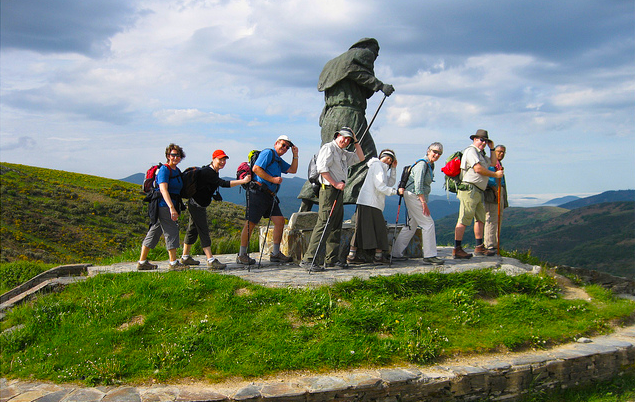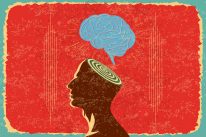
“If you do nothing unexpected, nothing unexpected happens.” ~Fay Weldon
In September of 2012, I flew from Idaho to Spain and began a 500-mile pilgrimage walk on the Camino de Santiago. I arrived in St. Jean Pied-de-Port without any expectations and a blank canvas in my mind. I will treasure the imaginary painting that developed over the next thirty-five days until my last breath.
This trail has attracted at least 2,000,000 people over the past 1,300 years.
From prior experience, I know that being in an environment where everything is on the outer edge of comfort zones always results in personal growth.
In this crucible, the sleeping quarters were group bunks, I did not speak the language, my phone rested on its cradle in Boise, and walking is a far cry from my preferred devotion to cycling.
The first third of the trip is for the body. The Pyrenees Mountains and subsequent hills challenge the muscles and stamina finds a new foundation.
The second portion is for the mind. The Meseta is 120 miles of flat and barren ground. With little scenic distraction, the mind is forced into meditation or inward reflection.
With a strong body and clear mind, the final 200 miles is for the soul. The lush foliage, steep mountains, and small streams compliment the landscape. Realizing that the end was near, my soul became a sponge and savored every tiny moment.
In retrospect, the trip mirrored an entire life cycle. Upon arrival, I had no idea about where to go, what to eat, or where to sleep. Like an infant, I relied on the kindness of strangers to help me.
Within a week, I graduated from baby to teenager. I walked without blisters, mastered the hostels, and made new friends. I knew everything!
The middle of the trip, like midlife, became a bit routine. Most days began at 6:30-7:00 with toast and coffee followed by walking, resting, lunch, walking, resting, and arriving.
In Santiago, the trip ended and there was a real finality to the adventure. My friends disappeared and the day-to-day joys terminated. Was it the end or just another beginning?
The time I spent walking to Santiago taught me a valuable lesson about getting there versus enjoying the journey. The enhancements to my life came in the form of meeting new friends, enjoying a cup of coffee con leche, and imbibing nature. The trip is about living, not arriving.
I spent a total of thirty-five days wandering through this wonderful corner of the world. If I am fortunate to live to be eighty years old, the time spent on the Camino will represent less that one-tenth of one percent of my life.
I cannot imagine a better investment of time to receive the benefit of such a powerful transformation.
Living life in the rear view mirror robs time from the present. While it is impossible to avoid a trip down memory lane, I use my past for learning instead of suffocation. I try to spend as little time as possible in this arena and make an early exit.
Spending time peering into the horizon of life can be a practical exercise, but also steals precious time from the moment. We cannot experience life when we focus on graduating, getting a raise, getting married, having the baby, sending the kids to college, waiting until retirement, or any other future moment.
Life happens now. On this magic path, I was sucked into the now. Each day was a new mystery and nothing was arranged or planned. Living in this manner does not allow for time to be wasted on the past or future.
While I was surrounded with strangers from all over the world, it felt like one big family walking each other home. When the plane landed in Idaho, reality became my welcome mat. Could I transfer the lessons to day-to-day life?
On the Camino, I walked without worry and everything seemed to work out just fine. Since returning, one of my main goals is to remove worry from life. While serving a good purpose for some people, cable news instilled negative thoughts in my mind, so I cut the cord.
After pulling the plug, I made a list of worries and came up with a total of twelve entries. I immediately crossed off nine as items that are completely beyond my control. Some of these include my own mortality and a dear friend’s addiction to alcohol.
When the remaining three items surface and demand attention, I pull out a piece of paper and create a gratitude list. I do not ignore my troubles, but choose to count my blessings and pay attention to long list of things that are going well in my life. I wake up and ask myself, “What is right today?”
When I drift into the past or the future, I recognize the waiver. This realization gives me the option to exit. Whatever the circumstances, I strive to be present.
The Camino is marked with simple yellow arrows that guide pilgrims across the entire 500-mile trail. At home, there are plenty of signs that provide direction and guidance for a better life.
Feeling trapped is a sign of a wrong job. Fatigue is a sign of energy being used to resist a true calling. Suppressing intuition is a major indicator that the path forward is the wrong route!
Hellos and goodbyes are a frequent and daily event on the Camino. It made me realize that all relationships have a natural ending. Instead of worrying about what may or may not happen, I choose to enjoy my friends and family in the moment.
The destination on the Camino is the Cathedral de Santiago and it represents the end. The enjoyment happens on the 500 miles that precede this point.
That’s the main lesson I took from this experience: it’s up to us to savor every step on our journey through life.
Photo by Fresco Tours
About Kurt Koontz
After retiring early at age 36, Kurt Koontz became a devout adventure traveler. He never considered writing a book until he walked nearly 500 miles across Spain in 2012. His book, A Million Steps, chronicles the journey. Kurt Koontz is available for select lectures and presentations.











 Though I run this site, it is not mine. It's ours. It's not about me. It's about us. Your stories and your wisdom are just as meaningful as mine.
Though I run this site, it is not mine. It's ours. It's not about me. It's about us. Your stories and your wisdom are just as meaningful as mine. 